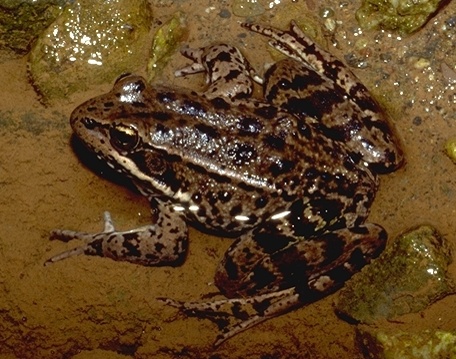


|
Ranidae :
Members of this family are known as the true frogs and occur worldwide, but they have a limited distribution in South America and Australia, but otherwise can be found throughout the world. They are absent in the West Indies and occur on a few oceanic islands. Size ranges from less than 50mm to 300mm in Conraua goliath, which is the largest known frog. Ranids have generalized frog body plans and generalized aquatic tadpole stage (although various types of direct development have evolved independently in many groups). Most have firmisternal pelvic girdles (some have overlapping coracoids but are fused to one another), and all have toothed upper jaw, cylindrical sacral diapophyses and have no intercalary cartilage between the penultimate and terminal phalanges. Habitats for these groups vary from dry to temperate to tropical. Currently, 11 subfamilies are recognized.
Genus :
Afrana (10 species)
Amietia (1 species)
Amnirana (11 species)
Amolops (37 species)
Anhydrophryne (2 species)
Arthroleptella (7 species)
Aubria (3 species)
Batrachylodes (8 species)
Cacosternum (10 species)
Ceratobatrachus (1 species)
Chaparana (6 species)
Conraua (6 species)
Discodeles (5 species)
Ericabatrachus (1 species)
Euphlyctis (4 species)
Fejervarya (27 species)
Hildebrandtia (3 species)
Hoplobatrachus (4 species)
Huia (8 species)
Indirana (10 species)
Ingerana (10 species)
Lankanectes (1 species)
Lanzarana (1 species)
Limnonectes (53 species)
Meristogenys (8 species)
Micrixalus (11 species)
Microbatrachella (1 species)
Minervarya (1 species)
Nannophrys (3 species)
Nanorana (3 species)
Natalobatrachus (1 species)
Nothophryne (1 species)
Nyctibatrachus (13 species)
Occidozyga (12 species)
Odorrana (6 species)
Paa (31 species)
Palmatorappia (1 species)
Petropedetes (10 species)
Phrynobatrachus (71 species)
Platymantis (59 species)
Poyntonia (1 species)
Pseudoamolops (2 species)
Pterorana (1 species)
Ptychadena (47 species)
Pyxicephalus (3 species)
Rana (254 species)
Sphaerotheca (7 species)
Staurois (3 species)
Strongylopus (11 species)
Tomopterna (9 species) |
